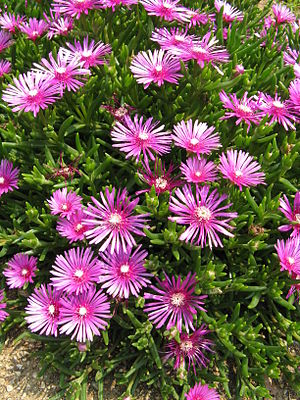Lampranthus
| Lampranthus | ||||||||||||
|---|---|---|---|---|---|---|---|---|---|---|---|---|

|
||||||||||||
| Systematics | ||||||||||||
|
||||||||||||
| Scientific name | ||||||||||||
| Lampranthus | ||||||||||||
| NEBr. |

Lampranthus is a genus of plants fromthe afternoon flower family (Aizoaceae). The botanical name is derived from the Greek words lampros for 'shining' and anthos for 'blossom' and refers to the brightly shining flowers of most species.
description
The species of the genus Lampranthus are upright to creeping shrubs , often with noticeably red shoots. Their paired, cylindrical or three-sided leaves are almost not fused together and only moderately xeromorphic. They are up to 2 inches long. The leaf surface is smooth and only occasionally spotted.
The flowers appear individually or in larger dichasias and are usually on short stems. They reach a diameter of up to 6 centimeters. There are five sepals . The numerous petals are often shiny and brightly colored. They are white, yellow, orange, red, or purple. Filamentous staminodes are usually present. The nectarium forms an inconspicuous, finely notched ring.
The five-compartment, dark brown capsule fruits have a long persistence. Their base is long funnel-shaped to bell-shaped, the tip raised. The mostly rectangular flap wings are large. The swelling strips diverge, the fan ceilings are strong. Closure bodies are not available. The fruits contain brown, pear-shaped seeds that are more or less smooth to a little papilla .
distribution
The distribution area of the genus Lampranthus extends in a wide band along the coast starting south of Lüderitz in Namibia over the South African provinces of Eastern Cape , KwaZulu-Natal , Namaqualand , and the provinces of Northern Cape and Western Cape . The majority of the species grow in the winter rain areas near the Cape of Good Hope . The species are distributed in very different habitats . They grow in sandy locations along the coast or on slate or clay plains. They are often found in rocky areas and on sandstone floors.
Systematics
The first description of the genus by Nicholas Edward Brown was published in 1930. The type species is Lampranthus multiradiatus . The genus Lampranthus includes the following species:
proof
literature
- Heidrun EK Hartmann (Ed.): Illustrated Handbook of Succulent Plants: Aizoaceae FZ . Springer Verlag, Berlin / Heidelberg / New York 2001, ISBN 3-540-41723-0 , pp. 75-108 .
- Gideon Smith et al. a. (Ed.): Mesembs of the World: Illustrated Guide to a Remarkable Succulent Group . Briza Publications, 1998, ISBN 1-875093-13-3 , pp. 326-333 .
Individual evidence
- ^ Nicholas Edward Brown: Mesembryanthemum and allied genera . In: The Gardeners' Chronicle . 1930, p. 71.
- ↑ Cornelia Klak: New combinations, a new genus and five new species in the Aizoaceae . In: Bradleya . Volume 21, 2003, p. 119.
Further literature
- Hugh Francis Glen: (537) Proposal to Conserve the Generic Name 2405 Lampranthus NE Br. (1930) against Oscularia Schwantes (1927) (Mesembryanthemaceae). In: Taxon . Volume 29, Number 5/6, 1980, pp. 693-694, ( JSTOR 1220349 )
- Cornelia Klak: Investigation into the systematics of the Lampranthus group (Aizoaceae) . in: Mesemb Study Group Bulletin . Volume 14, Number 2, 1999, pp. 30-34.
- Cornelia Klak: Recent studies in Lampranthus NEBr. In: Mesemb Study Group Bulletin . Volume 17, Number 4, 2002, pp. 70-75.
- Cornelia Klak: The genus Lampranthus (Ruschioideae, Aizoaceae) in South Africa . In: Cacti and other succulents . Volume 52, Number 2, 2001, pp. 29-36.
- Cornelia Klak, Terry A. Hedderson, H. Peter Linder: A Molecular Systematic Study of the Lampranthus Group (Aizoaceae) Based on the Chloroplast TrnL-trnF and Nuclear ITS and 5S NTS Sequence Data . In: Systematic Botany . Volume 28, 2003, number 1, pp. 170-185 ( doi: 10.1043 / 0363-6445-28.1.70 ).